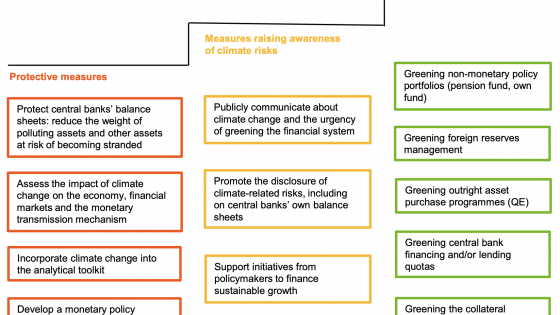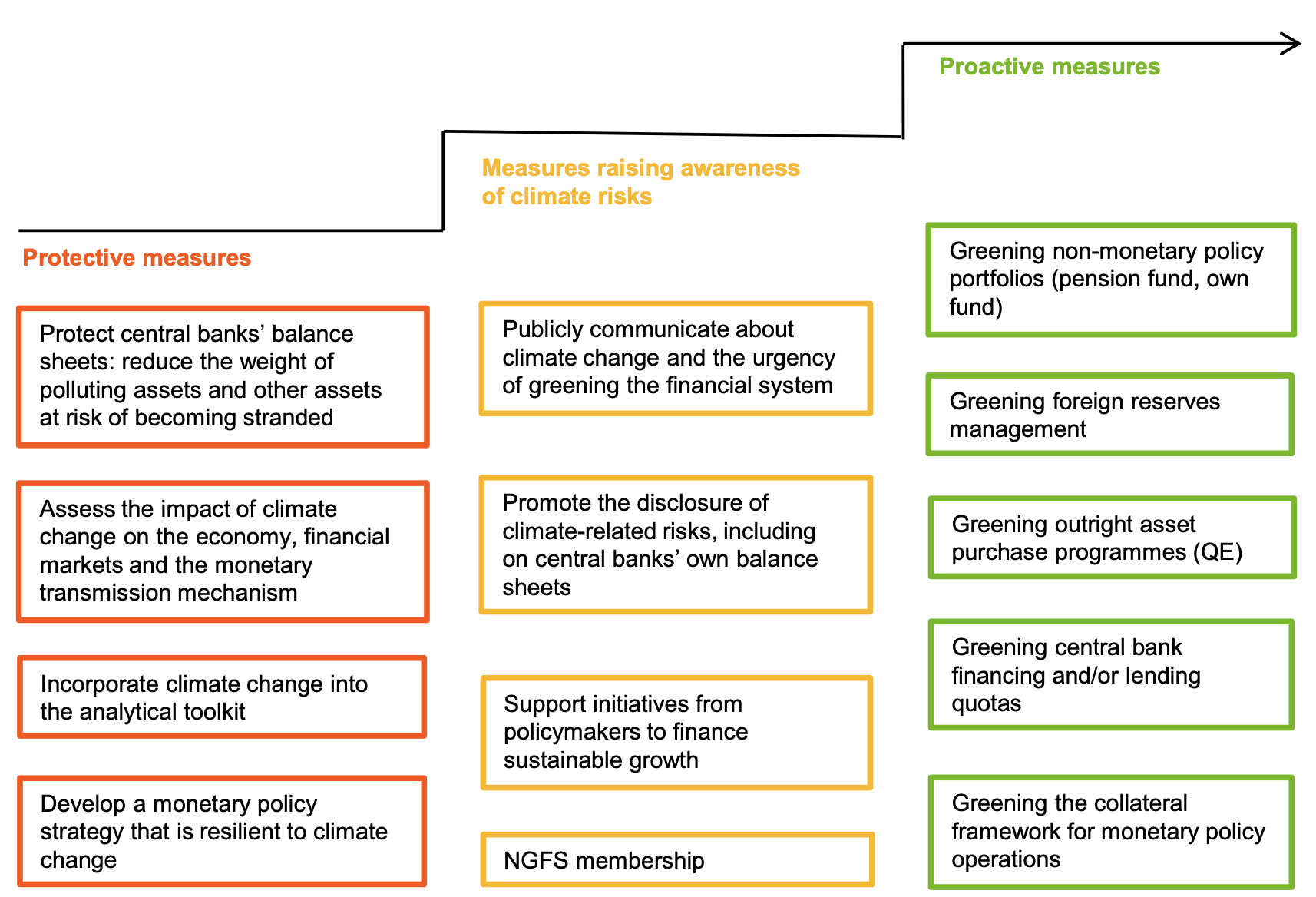
The role for monetary policy in the green transition
To be or not to be ‘green’, part 2: The role for monetary policy in the green transition
Search the site

To be or not to be ‘green’, part 2: The role for monetary policy in the green transition
Climate change is increasingly affecting our societies and economies. Adapting to it, and mitigating its consequences, requires a rapid transition to a low-carbon economy. The primary responsibility for this shift rests with governments. They are legitimised and have a broad spectrum of policy levers at their disposal, such as setting the necessary price of carbon emissions, defining a regulatory framework to reduce emissions, and undertaking needed sustainable investments. A global policy response is embodied in the 2015 Paris Agreement.
Yet, government action alone is not enough to address the complexity and scale of the transformation required to achieve climate goals, and there is a growing consensus that a comprehensive policy package would be more effective in tackling the multiple market failures at the roots of the climate challenge. Such a comprehensive policy package requires a mix of fiscal, regulatory, and structural measures as detailed in Pisu et al. (2022), as well as financial policy instruments and monetary policy measures of the type that we review further below (ECB 2021, Weder di Mauro 2021).
A key factor shaping central banks’ response to the climate challenge is the mandate that is assigned to them. When Dikau and Volz (2021) analysed the legislative mandates of 135 central banks, they found that only 12% have mandates that explicitly refer to sustainable growth or development. However, 40% are mandated to support the government’s policy priorities, which in most cases include sustainability goals.
For central banks with an explicit ‘green mandate’, the case for action is clear. But even in the absence of such a mandate, taking no action is not a viable option. There are several measures that central banks can and should consider, both to ensure that their policy frameworks remain resilient to emerging climate risks, and in terms of contributing to the decarbonisation objectives set by the relevant political authorities, supporting climate policies, and harnessing green finance.
The literature on the policy options available to central banks to respond to climate change is rapidly developing but still fragmented. In Boneva et al. (2021, 2022), we propose a classification of policy measures into three categories ranging from protective to proactive depending on their aim (Figure 1).
Figure 1 Possible central bank actions to respond to climate change

The first category includes measures protecting central banks’ balance sheets and preserving their ability to deliver on their price stability mandate against the materialisation of climate risks. Central banks have a duty to preserve the integrity of their balance sheets and prudently manage the resources entrusted to them as a means of ensuring that they are consistently able to deliver on their price stability mandate over time. Policies could be considered to reduce the weight of assets at risk of becoming ‘stranded’ in central banks’ portfolios, provided there is evidence that these risks are not correctly understood and priced by financial markets and that such assets can be objectively identified.1 Measures aimed at enhancing the central banks’ analytical toolkit to gauge the impact of climate change on the economy also belong to this category (NGFS 2021). Monetary policy frameworks should also adapt to climate-related risks and shocks (ECB 2021).
The second category includes measures aimed at raising awareness of climate risks that could also help to promote green finance and sustainable growth but without the central bank having to make an active use of its balance sheet. They cover a range of actions, from communicating with the public and financial community about climate risks to disclosing the carbon footprint of the central banks’ own balance sheets.2 These measures might benefit from a classification scheme to rank sectors and activities and sort polluting from green investments – such as the EU Taxonomy – promoting more efficient market pricing of climate risks. Many central banks and supervisors are also actively contributing to the work of the Network for Greening the Financial System (NGFS).
The third category includes actions aimed at proactively mitigating climate change and promoting the transition to a low-carbon economy, including through an active use of central banks’ balance sheets. Depending on central banks’ legal mandates and operational framework, active support for the transition to a low-carbon economy can be achieved by either changing the pricing of central bank facilities or changing the eligibility criteria (Figure 2). Given the size of current central banks’ balance sheets, the effects of greening central banks’ portfolios could be substantial in some cases. Moreover, there could be important signalling effects for market participants.
Figure 2 Greening central banks’ portfolios via the pricing or eligibility criteria

Non-monetary policy portfolios, such as staff pension funds and own funds, constitute a suitable starting point for actively greening central banks’ portfolios. Many central banks have already taken steps in this direction.
Recently, some central banks have also started allocating part of their foreign reserves to green securities. This is likely to create further trade-offs for reserve managers because of the potentially lower liquidity of green bonds and their still relatively small market share. However, in an illustrative exercise, BIS (2019) finds that holding both green and conventional bonds can help central banks improve risk-adjusted returns by reaping diversification benefits.
The policy portfolios of all major central banks have grown in recent years due to protracted asset purchases to achieve price stability. Many central banks carry out these purchases in proportion to outstanding market shares, a practice giving rise to a ‘carbon bias’ because carbon-intensive companies are usually also capital-intensive and so have a larger weight in corporate bond markets compared to their less carbon-intensive peers. Given this ‘climate change market failure’, traditional benchmarks for central banks assets purchases based on market neutrality might not be appropriate. Schoenmaker (2019) proposes a tilting approach that steers central bank asset holdings towards low-carbon companies. Similarly, bank lending also reveals a carbon bias, as discussed for example, in Beyene et al. (2021). To counter it, central banks might condition access to certain financing facilities on how much individual counterparties contribute to climate change mitigation and adaption through their lending, or how much they plan to do so in the future.3
Moreover, central banks can green their implementation framework by reviewing the pricing or eligibility criteria for collateral they accept as part of their lending operations. This could be done by introducing climate-related disclosure requirements for using private sector assets as collateral in central bank operations. Alternatively, central banks could pursue negative or positive screening for certain types of financial assets when used as collateral, if feasible.
Central banks taking an active role in raising awareness about climate risks are likely to encounter diverse constraints and face criticisms. Publicly communicating about the urgency to green the financial system could be perceived as an attempt to acquire more tasks and powers. Additionally, there is a risk of fuelling excessive expectations about what central banks can effectively achieve.
Another set of concerns regards the compatibility of central bank policies, which are typically aimed at smoothing business cycle fluctuations, to address the structural changes that are needed to tackle climate change: for example, if asset purchases are wound down as inflation reverts back to the central bank’s inflation goal, this type of instrument cannot be used to permanently support climate-related objectives. Nevertheless, the central bank could aim to set the desired monetary policy stance in a ‘green way’. Moreover, by reducing the transition costs for firms that invest to cut emissions, monetary policy may ease the path towards carbon neutrality, thereby generating some long-lasting effects.
Finally, greening monetary policy could distort financial markets, especially given the current scarcity of green assets. The transmission of monetary policy could be hampered if, for example, certain institutions are excluded from accessing central bank facilities. Moreover, in the absence of a clear taxonomy and accepted market standards of what is ‘green’ and what is polluting investment, and without implementable guidelines, central banks lack an objective definition and possibly a legal underpinning to ground their green policies. Given these constraints and trade-offs, central banks need to carefully balance the costs and benefits of any green action.
Authors’ note: The views expressed here are those of the authors and do not necessarily reflect those of the European Central Bank (ECB) or the Eurosystem.
BIS (2019), “Green bonds: the reserve management perspective”, Quarterly Review, September.
Beyene, W, M Delis, K de Greiff and S Ongena (2021), “Too big to strand? Bond versus bank financing in the transition to a low carbon economy”, VoxEU.org, 04 December.
Bolton, P, S Reichelstein, M Kacperczyk, C Leuz, G Ormazabal and D Schoenmaker (2021), “Mandatory corporate carbon disclosures and the path to net zero”, VoxEU.org, 04 October.
Boneva, L, G Ferrucci and F P Mongelli (2021), “To be or not to be ‘green’: how can monetary policy react to climate change?”, Occasional Paper Series, No 285, ECB.
Boneva, L, G Ferrucci and F P Mongelli (2022), “Climate change and central banks: what role for monetary policy?”, Climate Policy.
ECB (2021), “Climate change and monetary policy in the euro area”, Occasional Paper, No 271, ECB.
Dikau, S and U Volz (2021), “Central bank mandates, sustainability objectives and the promotion of green finance”, Ecological Economics 184.
Klusak, P, M Agarwala, M Burke, M Kraemer and K Mohaddes (2021), “Rising temperatures, melting ratings”, VoxEU.org, 25 March.
NGFS (2021), “Adapting central bank operations to a hotter world: reviewing some options”, March.
Pisu, M, F M D’Arcangelo, I Levin and A Johansson (2022), “A framework to decarbonise the economy”, VoxEU.org, 14 February.
Schoenmaker, D (2019), “Greening monetary policy”, VoxEU.org, 17 April.
Weder di Mauro, B (ed.) (2021), Combatting climate change: A CEPR collection, CEPR Press.
1 Klusak et al. (2021) inquire whether financial asset prices correctly reflect climate risks.
2 Bolton et al. (2021) document the benefits of mandatory corporate carbon disclosures to reduce emissions.
3 For example, concentration limits for high-polluting assets or minimum shares of low-polluting assets could be required for counterparties to access certain central bank facilities, as discussed in NGFS (2021).